If the thought of summer squash brings to mind images of yellow crookneck, and little else, get ready to discover so many different types!
These include straightnecks, zucchinis, patty pans, round cultivars, and even some with bold stripes and other intriguing patterns.
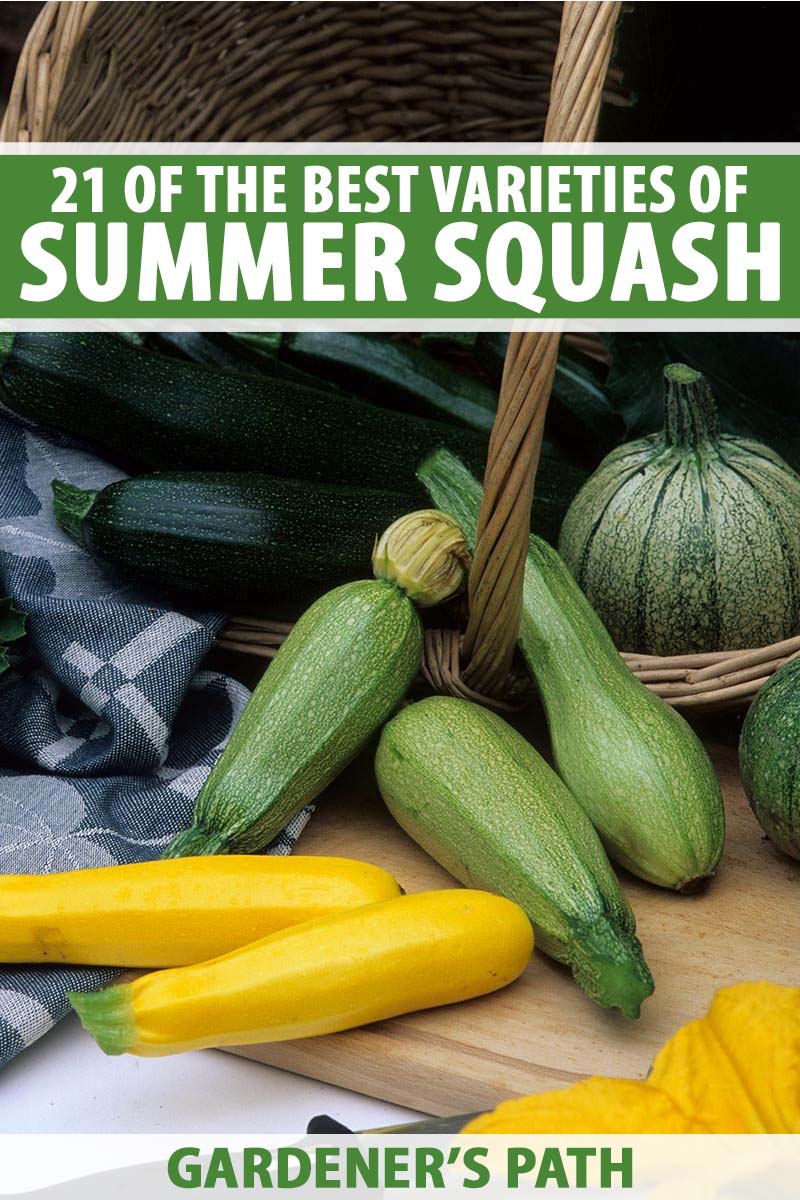
I’ve made a list of 21 of the best summer squash varieties you can grow in your garden. I’ve included some open-pollinated heirlooms with deep historical roots, some super productive and disease resistant hybrids – and some oddball varieties for the adventurous among us.
These members of the cucurbit family are all tender annuals and fairly quick to mature.
Unlike winter squash and pumpkins, which require a longer growing season, even if you find yourself reading this in midsummer, it may not be too late to get sowing!
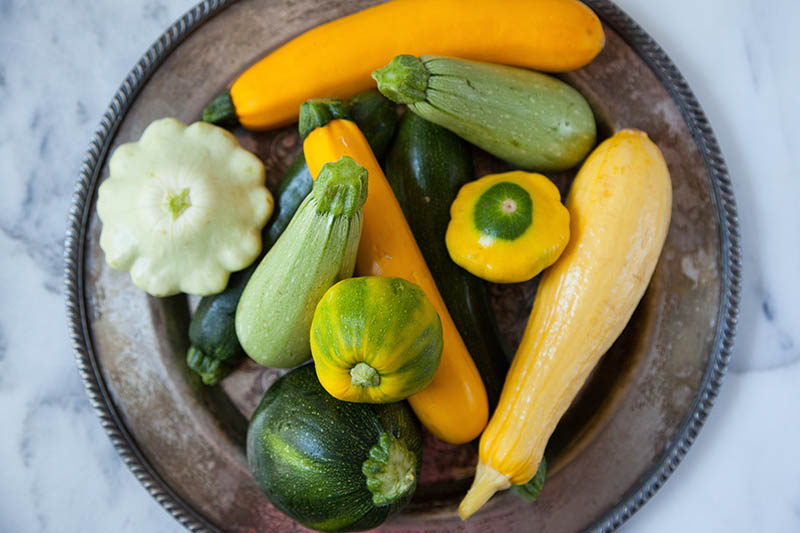
Summer squash has so many culinary uses, and some types are particularly well-suited for specific purposes, so I’ll make sure to point these out to you.
I’ll also let you know how big you can expect the plants to grow, when to harvest for best taste and texture, and how many days you can count on from sowing to harvesting.
Here’s a sneak-peak at my list:
21 of the Best Summer Squash Varieties
Crookneck
If you’re a foodie, and crookneck squash seems a bit too pedestrian for you, let’s take a moment to delve into its history.
In his excellent book “Heirloom Vegetable Gardening,” available on Amazon, William Woys Weaver offers very good evidence that yellow crookneck squash originated in New Jersey and was cultivated by the Lenape people prior to European colonization.
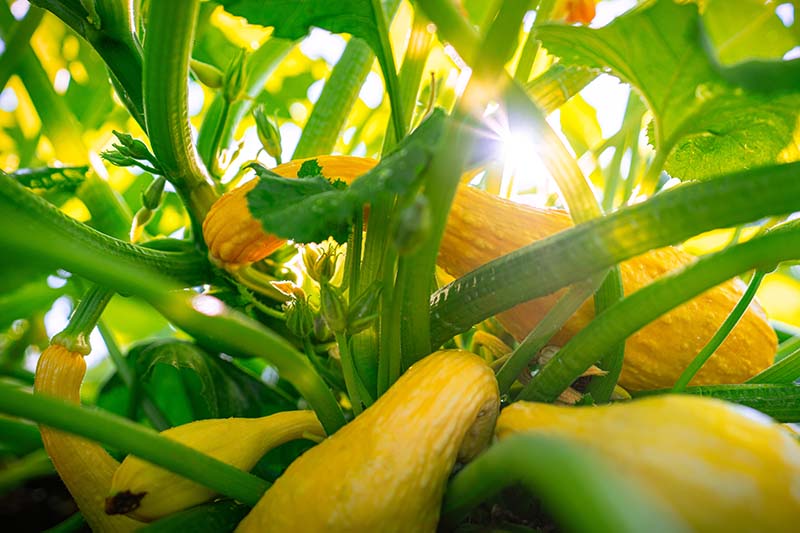
I don’t know about you, but for me that rich heritage gives it a whole new allure as a summer squash to grow in my garden.
Yellow crookneck varieties are recognizable by their slender, curved necks, and bulbous bodies.
The skin of these varieties can be smooth, bumpy, or downright warty – with wartiness increasing as the fruits mature.
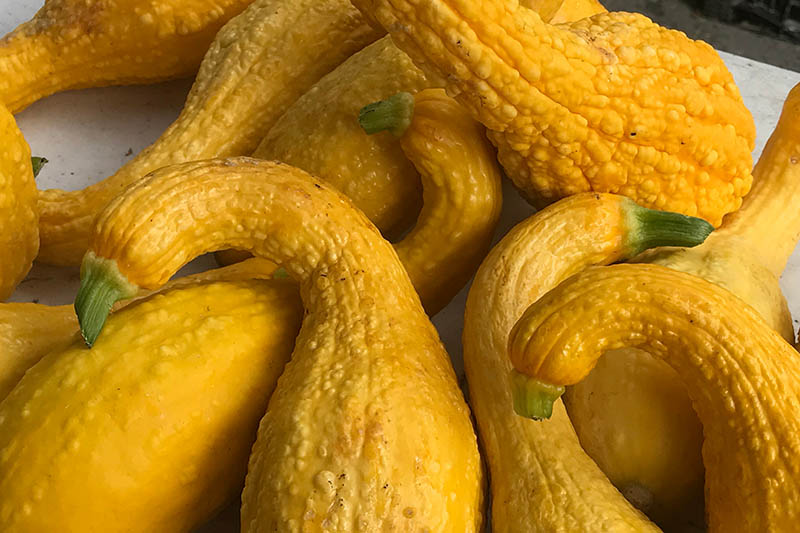
If you’ve only ever had yellow crookneck with flesh that was overwhelmingly seedy and watery – give it another chance and harvest it small, for better flavor.
Crooknecks can be baked, sauteed, grilled, or spiralized – and you can even turn them into a hearty soup.
For a delicious example of a yellow crookneck soup, check out the recipe on our sister site Foodal, for summer squash soup with cheesy zucchini crispies.
1. Early Summer
‘Early Summer’ is an heirloom, open-pollinated crookneck variety that has been sold in catalogs since 1928.
Fruits have narrow, curved necks, and are light yellow in color with semi-smooth skin. These crooknecks have a sweet and buttery flavor with a creamy, tender texture.
Best when harvested at 4-6 inches in length, ‘Early Summer’ crooknecks have small seed cavities and hold well after picking.
These summer squash grow on compact, semi-open bushes that reach 3-4 feet wide and 2 feet tall at maturity, and have some resistance to squash vine borers.
‘Early Summer’ is highly productive and fruit will be ready to harvest in 50 days.
You’ll find ‘Early Summer’ seeds in a selection of pack sizes available at Eden Brothers.
2. Pic-N-Pic
If the idea of being up to your elbows in summer squash doesn’t daunt you, you might try growing a prolific hybrid. ‘Pic-N-Pic’ is a crookneck squash hybrid that was bred for high productivity and good flavor.
Fruits are golden yellow with smooth, tender skin, and are best picked when 4-6 inches long.
Bushes have a 3-4 foot spread and grow 2-2 1/2 feet tall at maturity, with an open habit, which makes picking the fruit easy.
‘Pic-N-Pic‘ crooknecks will be ready to harvest in just 50 days.
You’ll find ‘Pic-N-Pic’ seeds in packets of 65 available at Burpee.
3. Supersett
Want that bumper crop of summer squash early? ‘Supersett’ is an early-maturing hybrid crookneck that provides generous harvests with delicate flavor.
Also known as ‘Superset,’ this variety produces fruits with glossy yellow, smooth skin. Fine-textured flesh has a sweet and nutty flavor.
Fruits should be picked at 5-6 inches in length.
‘Supersett’ grows on open bush plants with few spines and has excellent mildew resistance.
You’ll start harvesting these crooknecks in just 40 days.
Find packets of 25-30 seeds from Renee’s Garden Seeds via Amazon.
Yellow Straightneck
Yellow straightnecks are very much like crooknecks – but without the crook. Some home cooks prefer these varieties because the straight shape makes them easier to slice and chop.
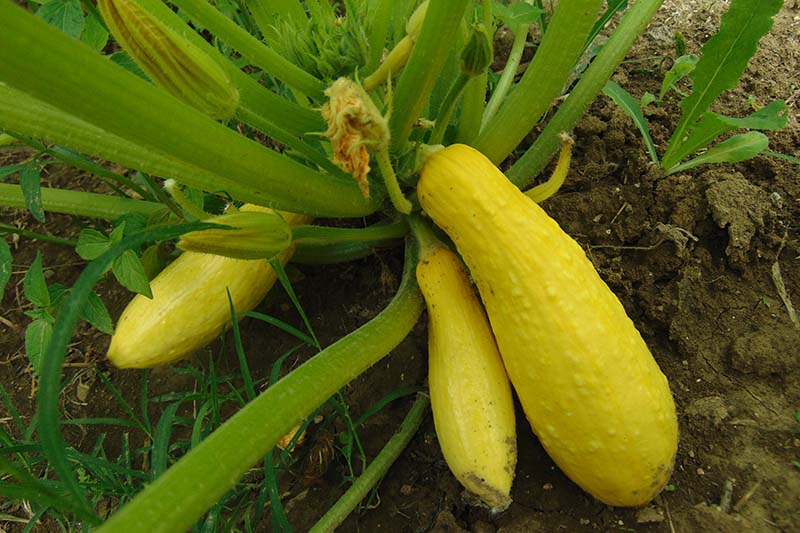
And many small market farmers prefer growing straightnecks to crooknecks because they are less prone to breakage during transport – no delicate necks to worry about.
Apart from the necks, straightnecks are very much like crooknecks – with slim necks and bulbous blossom ends.
Young fruits have thin skin that will become tougher as the fruit matures.
Fruits are yellow, or yellow with a green tint, and can be either smooth or bumpy, depending on the cultivar.
In the kitchen, straightnecks work well for sauteing, roasting, and grilling, and can be used as a replacement in pretty much any recipe that calls for zucchini.
In fact, yellow straightneck makes delicious spiralized noodles, and could be used in this mouthwatering recipe for zucchini spaghetti with peaches and pumpkin seed pesto from our sister site, Foodal.
4. Early Prolific
One of the most popular straightneck varieties, ‘Early Prolific’ is an open-pollinated heirloom that won the All-America Selections prize in 1938.
Plants produce light yellow, club-shaped summer squash that have slightly bumpy skin.
These straightnecks – best picked when 4-6 inches long – are well-loved for their buttery, nutty flavor.
Plants grow in an open, bushy form and have a 2-3 foot spread and grow 2-2 1/2 feet tall at maturity.
‘Early Prolific’ will be ready to harvest in 50 days.
You’ll find ‘Early Prolific’ seeds in a variety of packet sizes available at True Leaf Market.
5. Lioness
If you’ve had issues with disease in your squash plants in the past, you may want to try growing ‘Lioness,’ a hybrid variety with broad disease tolerance.
The fruits of this productive cultivar are yellow with a greenish tint – even when they are mature, and are best picked at 7 inches or smaller.
Plants have a bush habit with a 2-3 foot spread and reach 2-2 1/2 feet tall at maturity.
‘Lioness’ is resistant to zucchini yellow mosaic virus, watermelon mosaic virus, papaya ringspot virus, and cucumber mosaic virus. Fruit will be ready to harvest in 50 days.
You’ll find ‘Lioness’ seeds available for purchase in packs of 250 or 1000 from Harris Moran via Amazon.
6. Zephyr
‘Zephyr’ will stand out when you grow it in your garden, leaving you no mistake about which variety of summer squash it is.
The fruits of this high-yielding straightneck have an intriguing two-toned pattern. These summer squashes are yellow with light green ends, making them look like they got partially dipped in green dye.
How did these fruits get so beautiful? Developed by Johnny’s Selected Seeds, ‘Zephyr’ is a hybrid cultivar that has yellow crookneck, delicata, and acorn squash in its ancestry.
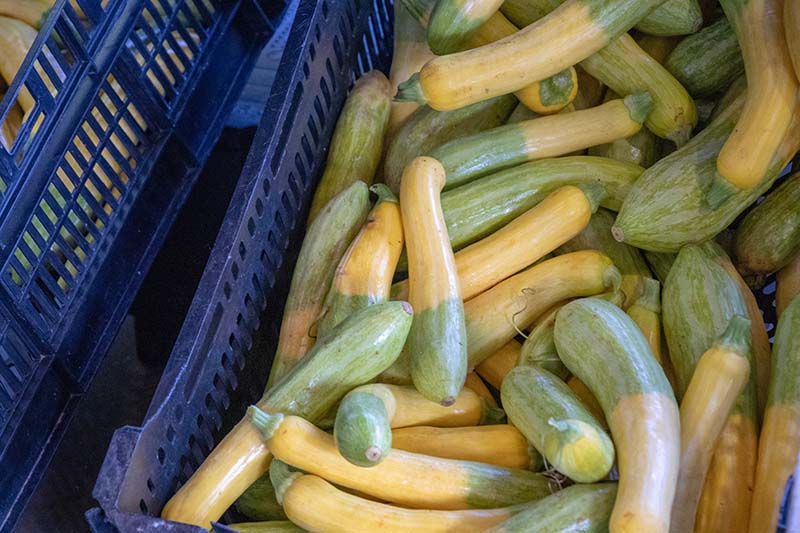
‘Zephyr’ is best harvested when fruits are 4-6 inches long, as the skin will become tougher as they get larger.
This cultivar also has a few quirks – some fruits may have crooks instead of being totally straight, and the first fruits to develop on the plants are sometimes yellow with green stripes.
Generally, fruits are yellow with a green tip at the blossom end and have faint white stripes that can become more distinct as they mature.
Fruits are tasty with a nutty flavor and firm texture, growing on 2-foot tall bushes with an open growth habit, making picking easy.
‘Zephyr’ has good general disease and insect resistance, and will be ready to start harvesting in 54 days.
You’ll find ‘Zephyr’seeds available for purchase in packs of 25 seeds from Legend Online via Amazon.
Zucchini
Like the other types of summer squash mentioned in this list, zucchini has its origins in the Americas – so why the Italian sounding name?
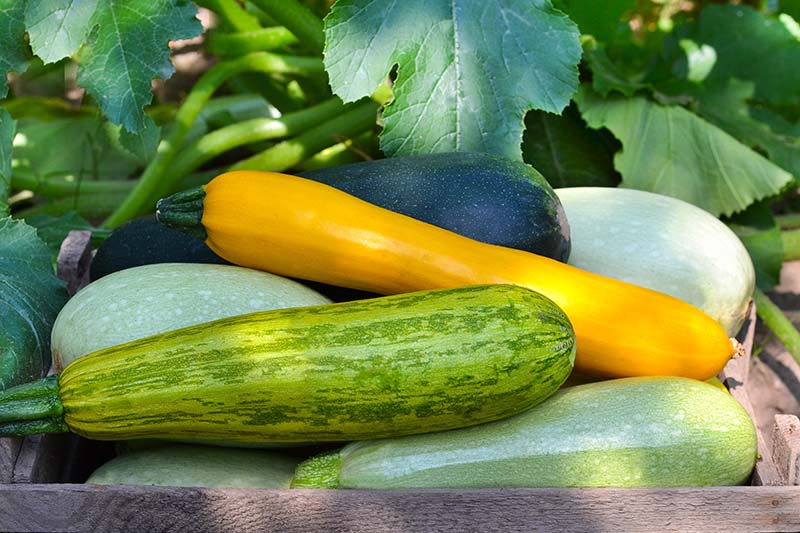
Although the species originated in the Americas, zucchini-type squashes were first cultivated in Italy.
You can learn more about zucchini’s history as well as helpful information for growing these plants in our complete guide to growing zucchini.
Compared to crookneck and straightneck varieties, zucchini have a straighter shape, thinner skin, and slightly flattened sides.
Zucchini is wonderful spiralized, steamed, sauteed, grilled, or fried.
And if you suddenly discover a baseball bat sized zuke growing on one of your plants, well darn, you’ll just have to make some zucchini bread. Such a tragedy.
If you need a recipe, there’s one for healthy and delicious zucchini bread on our sister site, Foodal.
7. Black Beauty
‘Black Beauty’ is a well-known, open-pollinated heirloom cultivar that has gained its popularity for good reason.
It won the All-America Selections prize in 1957, rewarded for its tasty fruit, abundant harvests, and ease of growing.
Long straight fruits have tender, dark green to black skin, and creamy white flesh. ‘Black Beauty’ is just as good raw as it is cooked, and makes an excellent cultivar for freezing.
Fruits are tasty, and usually best when picked at 8 inches long or less, though they often remain tender at much larger sizes.
Bushy plants are fast-growing, spreading 3-4 feet and growing to about 2 feet tall – with harvestable fruit in 50 days.
You’ll find ‘Black Beauty’ seeds available for purchase in an assortment of packet sizes at Eden Brothers.
8. Caserta
‘Caserta’ is another All-America Selections winner, this time from 1949.
Originally bred by the University of Connecticut, the fruits of this open-pollinated heirloom variety have a beautiful coloring – light green mottled with dark green.
Slender fruits are cylindrical and slightly tapered, with a rich, full-flavored taste, and a firm, creamy texture.
While these zucchinis are best picked at 8 inches in length, they often remain tender up to 16 inches long. Mottling can turn into more distinct stripes, particularly in mature fruit.
Bush type plants are vigorous and productive, growing 2 feet tall with a 3-4-foot spread at maturity.
‘Caserta’ will be ready to harvest in 60 days.
You’ll find ‘Caserta’ seeds in an assortment of packet sizes available at Eden Brothers.
9. Grey
‘Grey’ zucchini is a heat-resistant squash variety that will thrive when grown in arid locations, and is popular in Mexico and the Southwest.
Also called ‘Gray,’ ‘Tender Grey,’ and ‘Mexican Grey,’ fruits of this cultivar are stocky and colored light or dark greenish grey, with lighter colored flecks.
It’s best to harvest ‘Grey’ when fruits are around 7 inches long, though they often remain tender at much larger sizes.
Semi-bush plants grow to 24 inches tall with a 3-4-foot spread at maturity.
‘Grey’ has good general disease resistance and is ready to harvest in 45-60 days.
You’ll find ‘Grey’ seeds in an assortment of packet sizes available at Eden Brothers.
Striped Zucchini
Striped zucchini provide a little more visual interest than their unstriped summer squash counterparts.
But the interest of these varieties doesn’t stop at mere looks – many of these cultivars are extremely tasty – sometimes with more flavor than your average zucchini.
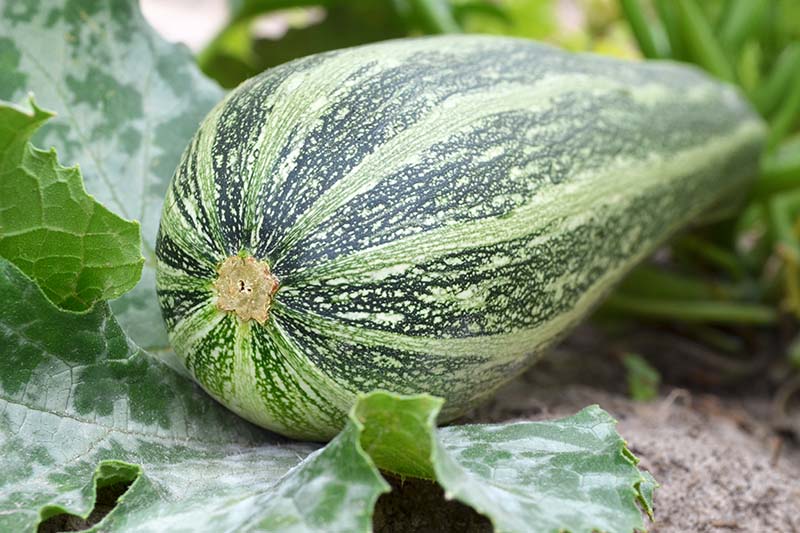
While there are some hybrid striped zucchini cultivars, many of these are Italian heirlooms. When you taste them, you’ll understand why these seeds were saved, grown, and cherished for generations.
Striped zucchini can be used just like other zucchini – for spiralizing, grilling, or making zucchini bread – but one culinary use that really shows off the stripes is to use these summer squash to make boats.
If you’ve never made zucchini boats before, have a look at this recipe for stuffed zucchini with millet, tomatoes, and olives on our sister site, Foodal.
10. Cocozelle
‘Cocozelle’ is an open-pollinated heirloom cultivar that was grown all the way back in the 1880’s.
The long, straight fruits have dark green skin with light green stripes and slight ribbing. They are extremely flavorful, with a slightly nutty taste and have dense flesh.
‘Cocozelle’ is at its tastiest when fruits are 6-10 inches long.
Bushy plants have an open growth habit and few spines, making picking a breeze. Plants mature to 3-4 feet wide and around 2 feet tall.
‘Cocozelle’ will be ready for picking in 45-60 days.
You’ll find ‘Cocozelle’ seeds in a variety of packet sizes available at Eden Brothers.
11. Costata Romanesco
‘Costata Romanesco’ is an open-pollinated heirloom from Italy that has gardeners coming back to it year after year for its superior flavor.
Embodying the “slow food” philosophy, it’s not a heavy producer compared to some summer squash, and is a little slower than others to get going – but once it does, its fruits are a treat.
Fruits are deeply ribbed, giving rise to its other moniker, ‘Italian Ribbed.’ When sliced, its cross sections look like little stars – offering a unique presentation for either fresh eating or frying.
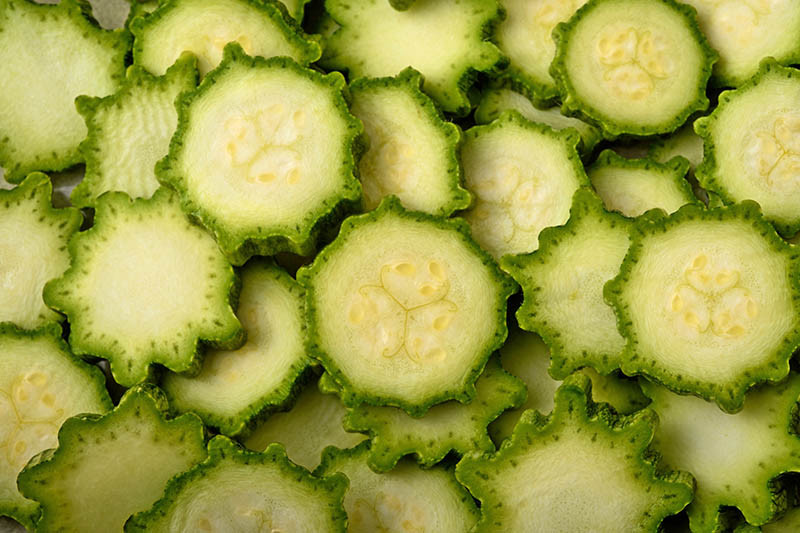
Fruits are dark green with narrow, light green stripes along the ribs, and light flecks. The dense flesh is never watery, and they have a distinctive, nutty flavor and tender skin.
‘Costata Romanesco’ is best picked when 6-8 inches long.
Plants produce lots of sturdy male flowers, which are excellent to use for making stuffed squash flowers, one of the traditional uses of ‘Costata Romanesco’ in Italy.
Plants are sprawling with vines growing up to 5 feet long at maturity, and are resistant to powdery mildew.
‘Costata Romanesco’ will be ready to harvest in 60 days.
You’ll find ‘Costata Romanesco’ seeds in a selection of packet sizes available at Eden Brothers.
12. Green Tiger
‘Green Tiger’ is a beautifully striped hybrid cultivar that comes with the bonus of disease resistance.
Cylindrical fruits are glossy with bold, dark and light green stripes, and not much flecking – and they are just as tasty as they look.
‘Green Tiger’ is best picked when fruits are 6-8 inches long, but can also be picked at 3 inches for baby zucchinis.
Bush type plants are upright with a 2-foot spread and grow up to 2-3 feet tall at maturity.
‘Green Tiger’ is resistant to watermelon mosaic virus and zucchini yellow mosaic virus, with first harvests in 55-60 days.
You’ll find 10 ‘Green Tiger’ seeds available for purchase at Burpee.
Yellow Zucchini
While you already have plenty of delicious zucchini options so far in this summer squash list, I would be remiss if I didn’t mention a handful of yellow zucchini cultivars.
The bright yellow hue will brighten up your meals, and some say they have a sweeter taste than their green counterparts.
Yellow zukes are also easier to spot on plants than green ones, making it more likely that you’ll pick them before they turn into mini submarines.
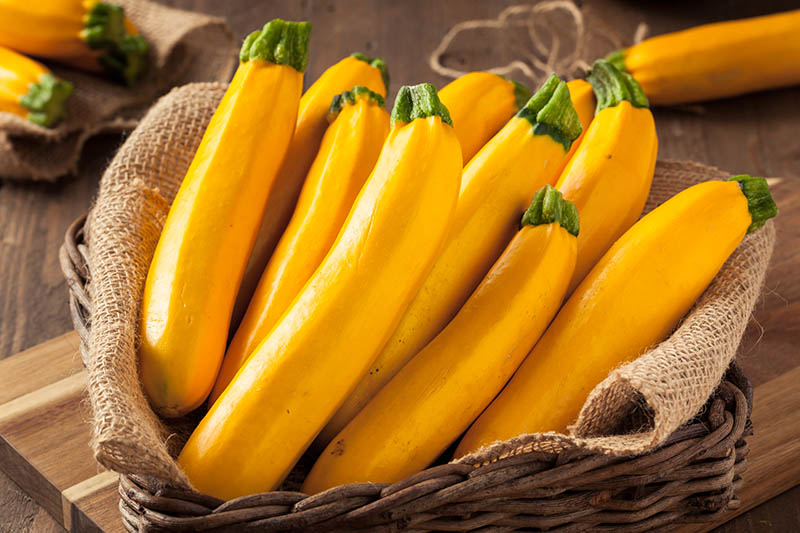
And if you’re wondering what the difference is between yellow straightneck and yellow zucchini, as far as eating goes, yellow zucchini is less watery than yellow straightneck, and has a nuttier flavor.
In the kitchen, yellow zucchini works well for spiralizing, sauteing, roasting, or eating as a crudite.
It would also be a star in a grilled veggie platter, like this recipe for grilled veggies with balsamic and garlic, also on Foodal.
13. Cube of Butter
‘Cube of Butter’ is a hybrid cultivar that provides generous harvests of tender yellow zucchini.
Fruits are lemon yellow with creamy white flesh and a succulent texture – and buttery flavor when eaten either cooked or raw.
Generally picked at 6-8 inches, these zucchinis will maintain their high-quality flavor and texture up to 10 inches long.
Open bush type plants mature to 3-4 feet wide and 2 feet tall, with few spines, which makes them easy to pick.
‘Cube of Butter’ has good general disease resistance, and in particular is resistant to zucchini yellow mosaic virus, downy mildew, and podi virus.
You’ll get your first harvests of these delectable yellow zucchinis in 50 days.
‘Cube of Butter’ is available for purchase in packs of 10 seeds from Botanical Interests via Amazon.
14. Golden Zebra
If yellow zucchini isn’t unique enough for you, how about one with a pattern? ‘Golden Zebra’ is a golden colored hybrid with faint white stripes.
Straight, cylindrical fruits are bright yellow with white stripes that become more pronounced as fruits mature.
‘Golden Zebra’ is a flavorful summer squash with a meaty texture, and is best picked at 7-8 inches long or smaller.
Bush plants are a compact 2-3 feet by 2-3 feet at maturity, and will give you your first harvest in 50-60 days.
You’ll find ‘Golden Zebra’ in packets of 30 seeds available at Burpee.
15. Rheinau Gold
If yellow zucchini sounds great but you’d prefer to grow an open-pollinated variety for saving seeds, consider ‘Rheinau Gold.’
This cultivar was developed in biodynamic conditions by organic seed company Sativa Rheinau, based in Switzerland.
Flavorful fruits have thin, golden yellow skin and don’t grow quite as large as most green varieties.
Bush plants grow in an open habit for easy picking, and produce a first harvest of summer squash in 50 days.
You’ll find ‘Rheinau Gold’ seeds available for purchase in 3-gram packs from Territorial Seeds via Arbico Organics.
Round and Oval
What if you could take a zucchini and reshape it to make it round? Great idea, right? Sorry, already been done.
The French and Italians beat us to this idea, having bred heirloom zucchini that are round in shape before the local US supermarkets even knew what zucchini was.
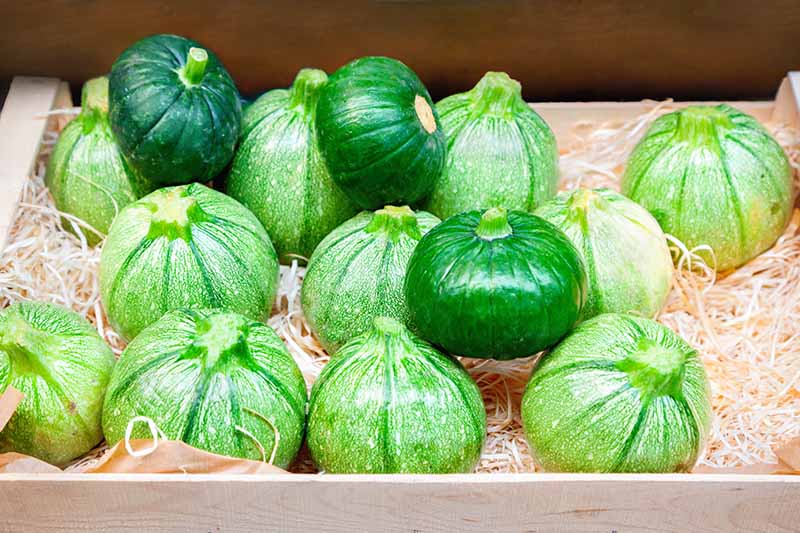
And along with these round varieties, there are also some that are oval in shape.
These types of summer squash are great for stuffing, and would be a good alternative to bell peppers for those following a nightshade-free diet.
Another one of my favorite uses for these is to slice them and stack them for making Mediterranean-style veggie timbales.
16. Golden Egg
‘Golden Egg’ is an early-maturing and prolific summer squash hybrid with a bright yellow hue.
The eye-catching fruits of this cultivar are egg-shaped, with greenish-white flesh, and a sweet and nutty flavor.
These are best when picked at 4 inches long, and are excellent for stuffing.
Yellow fruits are easy to see for picking on sprawling plants that can spread up to 6 feet at maturity.
‘Golden Egg’ will be ready to harvest in just 41 days.
You’ll find ‘Golden Egg’ seeds in packets of 25 available at Burpee.
17. Ronde de Nice
‘Ronde de Nice’ is a French heirloom dating back to the 1800’s that holds up well in hot climates and has good general disease and insect resistance.
This open-pollinated and extremely productive cultivar is also known as ‘Rond de Nice,’ ‘Round French,’ and ‘French Round.’
Fruits are round and milky-green colored, with a meaty texture and rich flavor, making them stars for stuffing, grilling, or braising.
For the best flavor and texture, ‘Ronde de Nice’ should be harvested when fruits are between 1 and 4 inches wide.
Plants grow in a compact bush shape, reaching mature dimensions of 3 feet wide and 3 feet tall, and have beautiful variegated leaves.
‘Ronde de Nice’ will be ready to pick in 52 days.
You’ll find ‘Ronde de Nice’ seeds in a variety of packet sizes available at Eden Brothers.
18. Tatume
‘Tatume’ is a pumpkin-shaped heirloom summer squash that is popular in Mexico and Texas. It’s very heat tolerant, and grows well in the Southwest.
Also known as ‘Calabacita,’ this high-yielding cultivar produces greenish-grey fruit with faint stripes.
‘Tatume’ has firm, flavorful flesh, and its prolific flowers are excellent for stuffing.
Pick these fruits when they are the size of a softball for best taste and flavor – or let them mature to bowling ball size and use them for zucchini bread instead.
‘Tatume’ has good general disease and insect resistance, particularly to squash vine borers.
Plants produce vigorous sprawling vines that can grow up to 12 feet long at maturity, with squash ready to harvest in 65 days.
You’ll find ‘Tatume’ seeds available for purchase in packs of 20 from Mseeds via Amazon.
Scallop
Scallop squash are also called patty pans, with both names referencing their resemblance to scalloped cake or pie pans.
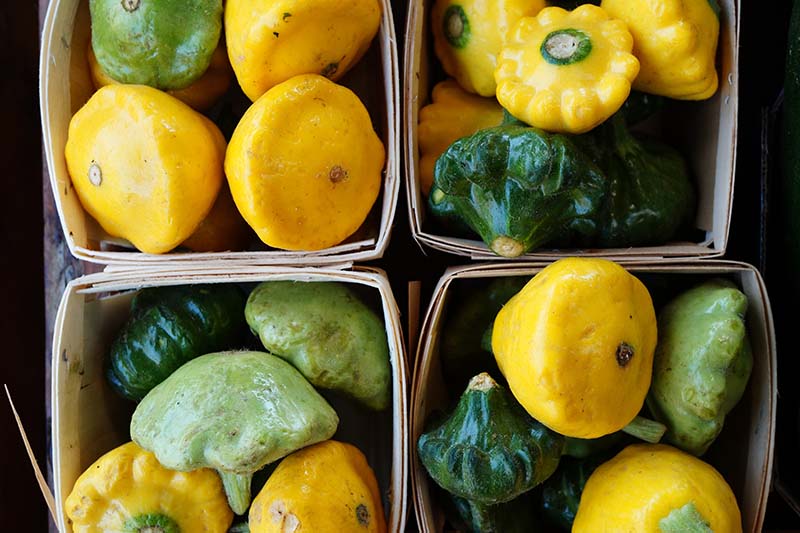
These are best picked small when the skin and seeds are still tender. If you happen to miss some though, larger patty pans can be peeled, and the tougher seeds removed.
Scallop squash can be sliced or cubed for sauteing, roasting, or frying. My favorite way to use these summer squash is to stuff them, which really shows off their unique shape.
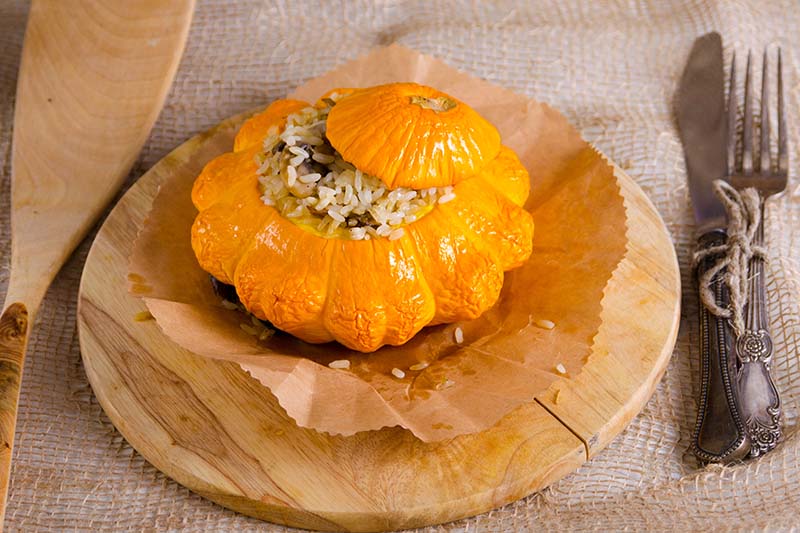
Also sometimes referred to as flying saucer squash, scallop varieties come in a range of colors, including white, yellow, green – and also patterned.
19. Bennings Green Tint
‘Bennings Green Tint’ is an open-pollinated heirloom scallop developed by Charles N. Farr, a market grower from the Benning neighborhood of Washington DC, who started selling the variety around 1896.
These patty pans are pale green in color, turning white as they mature.
A productive summer squash cultivar, it’s also known as ‘Farr’s Benning White Bush,’ ‘Benning’s Green Tint,’ and ‘Bennings Green Tiny.’
In keeping with that last name, these patty pans are best when picked small, at just 2-3 inches wide.
‘Bennings Green Tint’ is very tasty, with thin skin, and flesh that is both firm and creamy – just as Mr. Farr intended them to be.
Plants are compact, semi-open bushes that grow to be 3-4 feet tall and wide at maturity.
‘Bennings Green Tint’ will be ready for a first harvest in 50-60 days.
You’ll find ‘Bennings Green Tint’ seeds in a selection of packet sizes available at Eden Brothers.
20. Panache Jaune et Vert
‘Panache Jaune et Vert’ is a prolific French heirloom that dates back at least to the mid 1800’s.
This open-pollinated summer squash variety is also known as ‘Patisson Panache Jaune et Vert,’ ‘Patison Panache Green and Yellow,’ and ‘Variegated Scallop.’
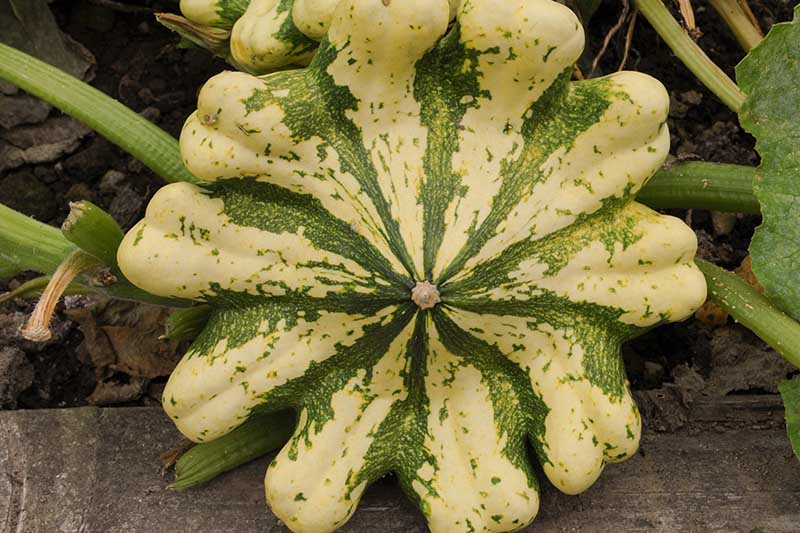
Fruits have creamy white to yellow skin, with green stripes or splotches, and flesh that is fine-grained, and very tasty.
Coloring can be somewhat variable in this cultivar, with some fruits lacking showy coloring – but once you taste them you won’t care what they look like.
‘Panache Jaune et Vert’ is best picked young, at 2-3 inches wide, but larger fruits are tasty too, and good keepers. They also make beautiful autumn decor if allowed to mature.
Bushy plants grow to 3-4 feet tall and wide, and bring their first fruits to maturity in 55-70 days.
You’ll find ‘Panache Jaune et Vert’ seeds in a selection of packet sizes available at Eden Brothers.
21. Sunburst
‘Sunburst’ is a tasty and prolific patty pan hybrid, and was the 1985 All-America Selections winner in the edible category.
Fruits are a stunning glossy bright yellow color with a dark green ring on blossom ends.
‘Sunburst’ produces scallop squash that have a mild, buttery flavor, a tender texture, with fine-grained, white flesh.
These summer squash have the best flavor and texture when picked at 2-3 inches wide, and can be cooked whole at this size.
Plants grow in a compact bush habit with a 3-4 foot spread and 2-3-foot height at maturity, are resistant to powdery mildew, and don’t mind cooler weather.
You’ll be harvesting ‘Sunburst’ in 50-55 days.
‘Sunburst’ seeds are available for purchase in a selection of packet sizes at True Leaf Market.
Calling All Squashbucklers
Alright gardener, you should now be prepared for some very squashy adventures.
These varieties should give you plenty of choice to grow bumper crops of summer squash – and just the kind you’ll enjoy cooking up in the kitchen.
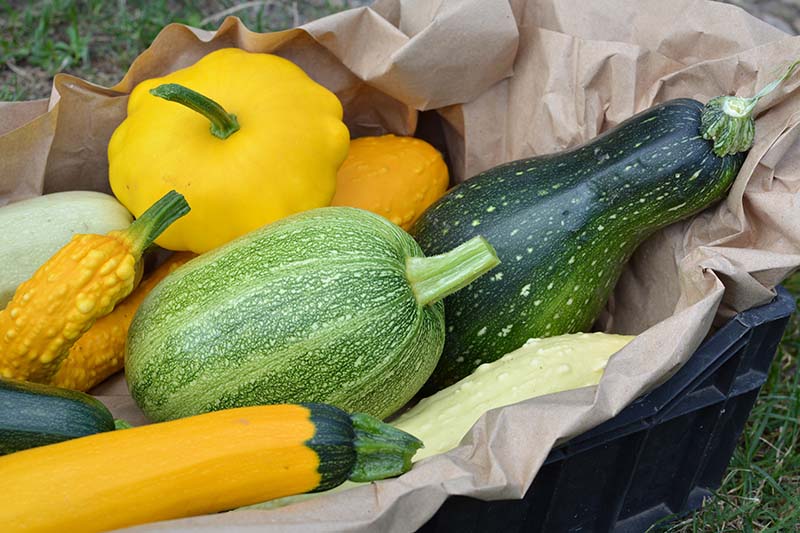
This year my summer squash line-up includes ‘Black Beauty,’ ‘Grey,’ ‘Cube of Butter,’ ‘Costata Romanesco,’ and ‘Tatume.’
Which varieties sound good to you? Do you have any other favorite types of summer squash? Let us know in the comments below!
Before you plant your seeds, how about some reminders on best practices for growing summer squash?
And while you’re at it, learn more about growing squash in your garden with these guides:
- Problems with Growing Zucchini: Troubleshooting 11 Potential Issues
- 11 of the Best Pumpkins to Grow for Pies, Puree, and Other Treats
- How to Grow Zucchini in Containers
© Ask the Experts, LLC. ALL RIGHTS RESERVED. See our TOS for more details. Product photos via Arbico Organics, Botanical Interests, Burpee, Eden Brothers, Harris Moran, Legend Online, MSeeds, Renee’s Garden Seeds, True Leaf Market, and Voyageur Press. Uncredited photos: Shutterstock.
The post 21 of the Best Summer Squash Varieties for Your Garden appeared first on Gardener's Path.
Source: gardenerspath.com
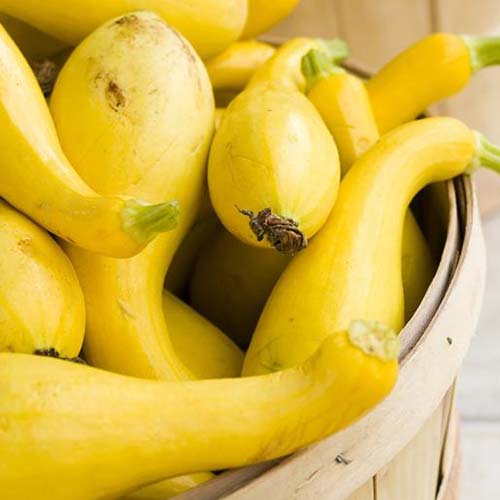
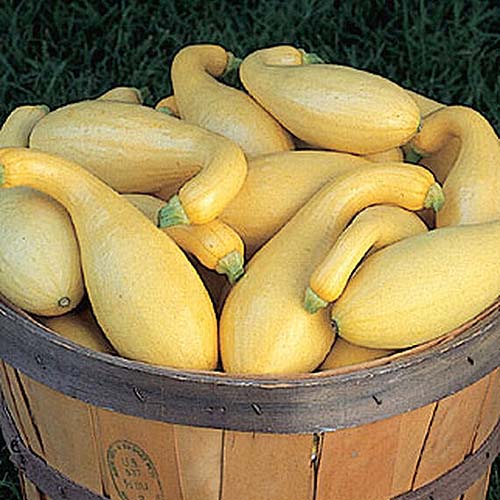

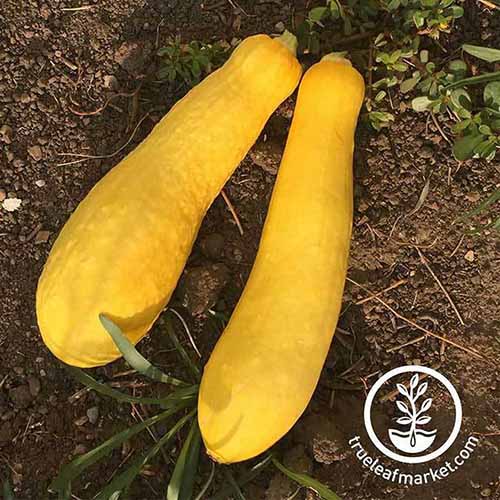

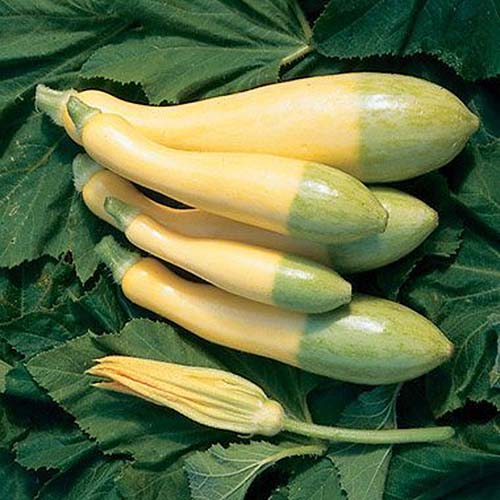

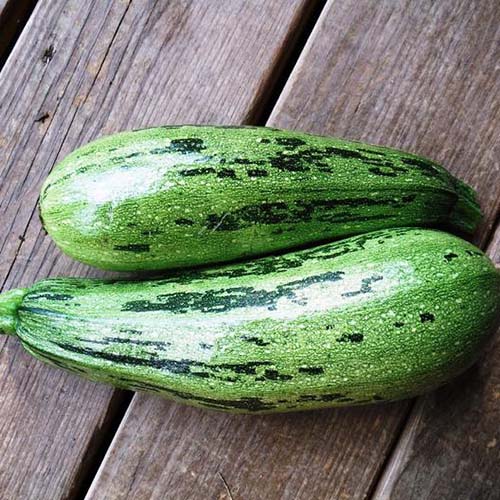

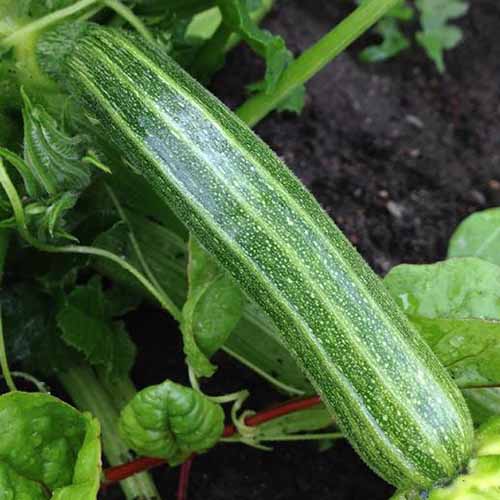
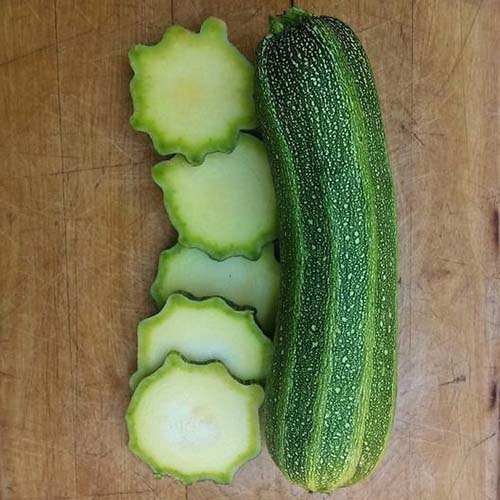

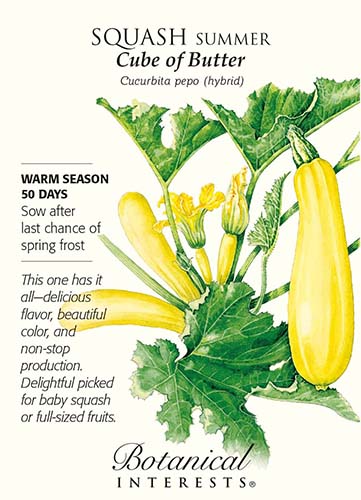
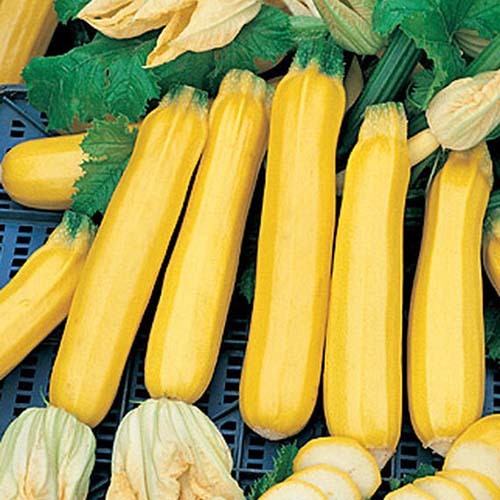

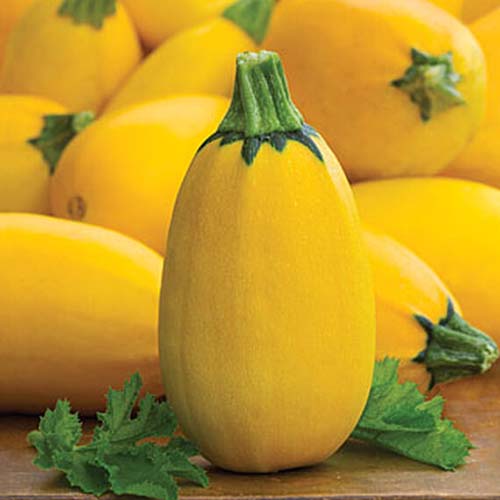


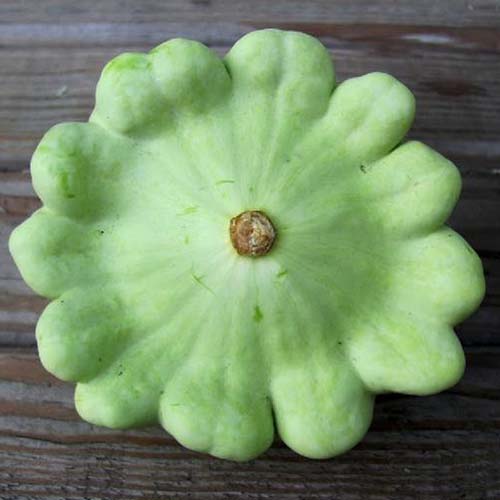
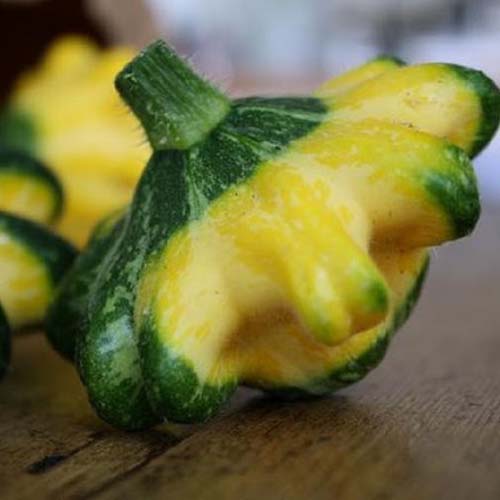
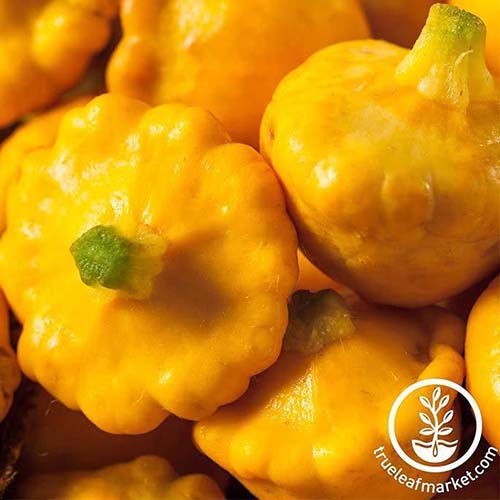

Комментариев нет:
Отправить комментарий